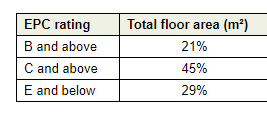Energy efficiency rules could make one-third of Scotland’s office space obsolete, warns Knight Frank

Toby Withall
Nearly one-third of Scotland’s office space could soon be at risk of being unusable if the Scottish Government follows the Minimum Energy Efficiency Standards (MEES) that apply to England and Wales, according to analysis from Knight Frank.
The independent commercial property consultancy found that 29% of Scotland’s office stock has an Energy Performance Certificate (EPC) rating of E or below. Under rules brought in on April 1st 2023 in England and Wales, non-domestic properties that fail to meet this standard cannot be let to an occupier.
The MEES rules will be tightened twice more in the coming years. From April 2027, commercial properties will need at least an EPC rating of C to be lettable, while in 2030 this will rise again to only buildings that achieve an A or a B rating.
If Scotland follows a similar path, more than half – 55% – of office space will need to be brought up to a C rating or better. Just one-fifth, 21%, of current office space in Scotland is rated B or above – with 8% achieving A or A+.
Edinburgh has the highest percentage of properties rated C or better of Scotland’s three largest cities, with 53%. Meanwhile, Aberdeen has the highest percentage of space with an A or B rating at 24%.
The Scottish Government is aiming for the country to be net zero by 2045 – five years ahead of the UK. Interim goals of reaching 75% and 90% of the overall target have been set for 2030 and 2040, with the built environment responsible for 39% of global energy-related carbon emissions according to the World Green Building Council.
A consultation document recently released by the Scottish Government set out its intention to align with the English EPC system and to reduce the validity of EPCs from ten years to five.
Current Scottish office stock by EPC ratings: 
Toby Withall, office agency partner at Knight Frank, said: “It seems inevitable that there will be some form of legislation coming in Scotland that reflects what the UK Government has sought to do with MEES. With the Scottish Government setting an earlier net zero target and the built environment known to account for a significant share of emissions, it is only a matter of time before building owners will have to take action. Even in the absence of legislative pressure, many corporate occupiers have their own net zero targets and will not consider space with an EPC rating below B.”
Gordon Hamilton, building consultancy partner at Knight Frank, commented: “We’re working with a range of landlords who are keen to get the EPC ratings of their buildings to as high a level as possible, given the direction of legislation and demands from current and prospective occupiers. There are a range of steps you can take, whether it is improving the mechanical and electrical features of a building or, in more extreme cases, potentially recladding the exterior.”
Euan Kelly, capital markets partner at Knight Frank, added: “From a capital markets perspective, we are increasingly finding that investors have their own carbon targets to achieve and won’t consider assets below a certain standard. Where work has not already been undertaken, they want to see a clear pathway to bringing EPC ratings up. Office assets that require a significant amount of work are also seeing this reflected in pricing, with a ‘brown discount’ – where buildings have poor ESG credentials – now becoming common.”





















